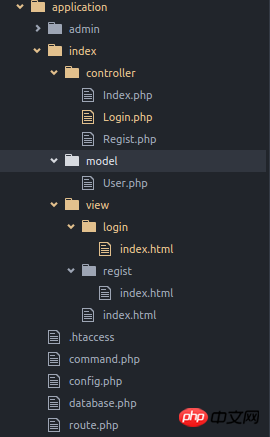Home > Article > Backend Development > ThinkPHP5 development (1) Detailed explanation of the login function (picture)
Mainly start from these three aspects:
Database
PHP code
HTML code&ThinkPHP view template code
The database uses mysql5 .7. And use the latest version of PHP PHP7, apache2.4, Ubuntu16.04
Preparation:
Download the thinkphp5 code, put it in the apache directory, and grant 777 permissions
chmod 777 -R tp5/
Open your project using atom or sublime or PhpStorm and prepare for coding
Database thinkphp5
-- phpMyAdmin SQL Dump -- version 4.4.15.5 -- http://www.phpmyadmin.net -- -- Host: localhost -- Generation Time: 2016-07-06 20:42:33 -- 服务器版本: 5.7.12-log -- PHP Version: 7.0.7 SET SQL_MODE = "NO_AUTO_VALUE_ON_ZERO"; SET time_zone = "+00:00"; /*!40101 SET @OLD_CHARACTER_SET_CLIENT=@@CHARACTER_SET_CLIENT */; /*!40101 SET @OLD_CHARACTER_SET_RESULTS=@@CHARACTER_SET_RESULTS */; /*!40101 SET @OLD_COLLATION_CONNECTION=@@COLLATION_CONNECTION */; /*!40101 SET NAMES utf8mb4 */; -- -- Database: `thinkphp5` -- -- -------------------------------------------------------- -- -- 表的结构 `think_user` -- CREATE TABLE IF NOT EXISTS `think_user` ( `user_id` int(11) NOT NULL, `user_name` varchar(255) NOT NULL, `UserSex` int(11) DEFAULT NULL, `UserTel` varchar(255) DEFAULT NULL, `UserEmail` varchar(255) DEFAULT NULL, `UserAddress` varchar(255) DEFAULT NULL, `UserBirth` varchar(255) DEFAULT NULL, `UserJoinTime` varchar(255) DEFAULT NULL, `UserPasswd` varchar(255) DEFAULT NULL, `UserSignature` varchar(255) DEFAULT NULL, `UserHobby` varchar(255) DEFAULT NULL ) ENGINE=InnoDB DEFAULT CHARSET=utf8mb4; -- -- 转存表中的数据 `think_user` -- INSERT INTO `think_user` (`user_id`, ` user_name`, ` UserSex`, `UserTel`, ` UserEmail`, ` UserAddress`, ` UserBirth`, ` UserJoinTime`, ` UserPasswd`, ` UserSignature`, ` UserHobby`) VALUES (0, 'thinkphp', 1, '15700000000', 'emial@email.com', '山东省济南市****路', '1111111', '111111', 'qqq', NULL, NULL); -- -- Indexes for dumped tables -- -- -- Indexes for table `think_user` -- ALTER TABLE `think_user` ADD PRIMARY KEY (`user_id`); /*!40101 SET CHARACTER_SET_CLIENT=@OLD_CHARACTER_SET_CLIENT */; /*!40101 SET CHARACTER_SET_RESULTS=@OLD_CHARACTER_SET_RESULTS */; /*!40101 SET COLLATION_CONNECTION=@OLD_COLLATION_CONNECTION */;
First set up the framework, run it, and then enhance it.
2. Write PHP code according to the thinkphp5 manual on "Looking at the Cloud"
Here you can directly use the script provided by ThinkPHP5 that can directly generate code, or you can manually create a directory and file
applicationDirectory Structure 
Login.php
fetch('index');
}
public function login($user_name='',$user_passwd=''){
$user = User::get([
'user_name' => $user_name,
'UserPasswd' => $user_passwd
]);
if($user){
echo '登录成功'.$user_name.md5($user_passwd);
}else{
return $this->error('登录失败');
}
}
}User.php
3 . View code HTML
Use native HTML, CSS does not use the front-end framework
Rendering:
login/index.html登录
After reading the ThinkPHP5 manual, I haven’t solved it yetVerification codequestion.
ThinkPHP's debugging tool can directly see the database password and the password submitted by the user, although I use the POST submission form.
After logging in, you need to do Session, write the login log, record the login time, IP and other information
And some more Security Question…
The above is the detailed content of ThinkPHP5 development (1) Detailed explanation of the login function (picture). For more information, please follow other related articles on the PHP Chinese website!